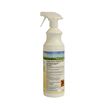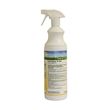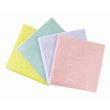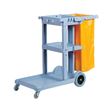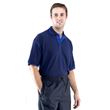Want to combat MRSA?
Methicillin Resistant Staphylococcus Aureus or for short MRSA is an area, which over the last few years has become of utmost concern to the care sector.
MRSA is an organism common to approximately 30% of our population, we carry it on our skin and in our nasal passages…mainly without any problems. Staphylococcus Aureus can cause various infections most of which are easily treated.
However, certain strains of Staphylococcus Aureus have evolved and become resistant to antibiotics, these are known as Methicillin resistant. If these Methicillin resistant strains enter the body via a wound, post operative wound, pressure sore or via a drain or line into the blood stream, it can cause major problems.
Areas we should consider
• Hand contact areas
• Hand hygiene
• Laundry
• Cleaning & disinfection
• Protective clothing
• Tested products
A guideline of the Department of Health on MRSA and infection control highlights that "The prevention of the spread of MRSA within a care environment is much dependant on the proper understanding and practice of universal infection control procedures"
It is a fact that MRSA is most commonly transferred via hand carriage, for example, a person sneezes onto a surface, the bacteria is then moved by other people then touching that surface and moving it to other surfaces and ultimately via cross contamination, the bacteria could then go on to enter an open wound, pressure point, etc.
Perhaps a lesser known area of concern is the laundry, here we have the potential again for cross contamination via hand carriage. If we consider that the items in the laundry have been in close contact with individuals for often, long periods of time. These fabrics can easily become infected and thus need to be handled safely and washed appropriately.
It is therefore most important to have in place proper cleaning/disinfection procedures together with hand hygiene guidelines being adhered to.
Hand contact areas
Housekeeping managers should be assessing their environments and identifying areas as low or high risk. These findings should then form the foundation for staff training and if necessary, new cleaning schedules which reflect the areas of greater importance/risk.
It is sensible to assume that the more people or traffic an area
receives then the higher the risk should be for that area, for
example;
• Communal areas
• Lounges
• TV rooms
• Remote controls
• Seating/arm rests
• Handrails
• Door handles
• Washrooms
Hand hygiene
Widely recognised as being the greatest cause in the transmission of Methicillin Resistant Staphylococcus Aureus.
• Hands need to be washed before and after contact with
each patient/resident
• Before and after starting work
• After using the toilet/blowing the nose
• After coming into contact with potentially contaminated
items/areas
• After soiling
Hands should be washed thoroughly paying attention to both the front/back/under nails and upto the wrist area. Then rinsed thoroughly and ideally dried with paper towels.
Alcohol Hand Sanitiser should be readily available and used if necessary along with the bactericidal hand soaps.
Laundry
Here we need to consider how the laundry is moved to the laundry room itself and also what happens to it when it arrives.
In order to avoid cross contamination the people who are for example, stripping a bed, need to be wearing disposable gloves and ideally disposable plastic aprons in order to avoid contaminating their workwear and transferring any bacteria elsewhere.
The laundry should really be placed directly into a red dissolving bag so that once it arrives at the laundry staff there can have minimum handling and place the bag directly, into the washing machine.
Once in the washing machine there are two approaches which The Department of Health considers acceptable for infection control;
• Chemical disinfection
• Temperature control
Utilising chemical disinfection along with temperature control will maximise your bacterial efficacy. Ensure that the product you are using is tested and certified as effective.
The Department of Health offer two temperature options which they deem suitable
• 65 degrees for a minimum of ten continuous minutes
• or 71 degrees for a minimum of 3 continious minutes
You will need to consider the fabrics and ensure that they are able to tolerate such heat.
Cleaning & disinfection
In order to control and minimise cross contamination within your environment effective cleaning schedules need to be in place and adhered to. These need not be especially complex, however we would recommend that any schedule would include all the areas to be cleaned, the frequency and the designated cleaning product.
Ideally any such schedule would be auditable ie, the staff member responsible for a specific cleaning task should be signing to say that the cleaning job was completed.
Generally, bacteria is easy to clean particularly from hand surfaces. The great increase of infections within our care industry coincides with a universal decrease in cleaning and disinfection standards.
MRSA is particularly resistant to some disinfectant. Being a very resistant bacteria, disinfection strength is essential and staff should be trained in the use/dilution/application of the cleaning products that they are using if our cleaning schedules are to be optimised.
It is important to ensure that products you are using are tested and certified by an independent laboratory to ensure that they are effective against MRSA.
Look for the BS EN 1276 this is a European standard which shows that the products will kill 99.999 of bacteria at a specified dilution rate. We have quite an extensive range of products tested and certified to this standard mentioned further on.
Protective clothing
We touched on this area a little when we looked at the laundry. Basically when cleaning we would always recommend that gloves and aprons are worn. By doing this and by disposing of these items and changing to fresh when necessary, you are minimising cross contamination via clothing and hand carriage.
Tested products
Within our range of cleaning products we have disinfectants tested to BS EN 1276, the European standard. The testing was carried out by the British Analytical Board, an independent body. We have products tested which are suitable for washrooms, kitchens, general housekeeping, hand care and of course the laundry.
Click here to view our products which combat MRSA



